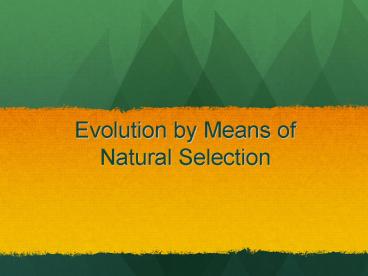Evolution by Means of Natural Selection - PowerPoint PPT Presentation
1 / 44
Title:
Evolution by Means of Natural Selection
Description:
Evolution by Means of Natural Selection – PowerPoint PPT presentation
Number of Views:72
Avg rating:3.0/5.0
Title: Evolution by Means of Natural Selection
1
Evolution by Means of Natural Selection
2
- Over a great period of time evolution can result
in the formation of a new species. - This is called?
- Speciation
3
- Evolution only occurs when there is a change in
___________________________ within a population
over time. - GENE FREQUENCY
1st generation of Beetle population
Many generations later of the same population
4
Mutation
- A change in a DNA sequence, usually occurring
because of errors in replication or repair. This
is the ultimate source of genetic variation.
5
Migration
The chance of an individual moving to another
population and sharing its genes there.
6
Genetic Drift
- The drift over time of allele frequencies in a
population due to random sampling effects forming
successive generations.
7
Natural Selection
- A process of evolution in which traits that
result in better fitness of an individual
survives to the next generation.
8
- "One obstacle to understanding evolution is the
common misconception that individual organisms
evolve. - It is the population, not its individuals, that
evolves, as some heritable variation becomes more
common at the expense of others."
9
What influenced Darwin to develop the theory of
evolution?
- Fossil Record
Fossil Record
Geographic Distribution
Embryology
Homologous Structures
Vestigial Structures
Artificial Selection
10
What Do Modern Scientists use as evidence of
evolution?
- Similar Biochemistry
- DNA
- ATP
- Hormones
11
(No Transcript)
12
(No Transcript)
13
Natural Selection
The Modern Understanding of Darwins Principles
14
Adaptations
- Hereditary characteristic that helps an organism
survive and reproduce under a certain set of
environmental conditions. - Example color patterns can be advantageous to an
animal, making it inconspicuous to its predators
15
The Co-evolution of Predator and Prey
- Consumption of one species (the prey) by another
(the predator) - Natural selection shapes the body forms and
behaviors of both predator and prey
16
Natural Selection, Predators, and Prey
- Prey that can survive attacks from predators will
reproduce and pass those traits down to their
offspring. - Predator that can beat the competition for food
will survive and reproduce, passing on their
traits to their offspring
17
- The predators with the best hunting equipment
will survive and reproduce, passing on their good
hunting traits
18
Acute Senses
19
(No Transcript)
20
(No Transcript)
21
- The prey with the best way of avoiding predators
will survive and reproduce, passing their traits
to the next generation. - Predator and prey both evolve more efficient ways
to interact. They adapt to each other.
22
Mimicry - the ability of some creatures to
imitate others, either by sound or appearance for
protective purposes
23
(No Transcript)
24
(No Transcript)
25
- Camouflage - Protective coloring or another
feature that conceals an animal and enables it to
blend into its surroundings.
26
(No Transcript)
27
(No Transcript)
28
(No Transcript)
29
Chameleon
30
Stick Bug
31
Warning Coloration
- Conspicuously recognizable markings of an animal
that serve to warn potential predators of the
nuisance or harm that would come from attacking
or eating it. The bold patterns of skunks and the
bright colors of poison arrow frogs are examples
of warning coloration.
32
The Role of the Environment
- When the environment changes, organisms are
forced to adapt. - Hereditary characteristics help organisms survive
and reproduce under a certain set of
environmental conditions. - What are some examples of big environmental
changes?
33
What Limits a Population?
34
- Carrying Capacity the number of individuals
that an environment can support - Affected by predator prey relationships and the
environment
35
(No Transcript)
36
(No Transcript)
37
Competition- When two or more organisms go after
the same limited resources
- In an environment resources that support a
population are limited.
There is only so much food, space, water, and
other essentials available to support the
population
We call these resources that support a population
but have the chance of running out, LIMITED
RESOURCES
38
When populations grow, competition increases, as
limited resources decrease.
Only those with better adaptations will survive,
and the weak will struggle. SURVIVAL OF THE
FITTEST! Natural Selection
39
Bear and Salmon
40
A lag phase (very few organisms to begin with
reproduction is slow B acceleration phase C
exponential phase F population crash due to
limited resources
41
Predator Prey Relationships Balance Populations
- Predator Prey relations are important to balance
an ecosystems populations.
If prey populations increase what will happen to
the predator population?
It will increase due to the larger amounts of
food available.
42
You can see an obvious cycle, prey numbers go up
followed by predator numbers going up, then prey
drops, predators drop
43
(No Transcript)
44
If the deer population became out of control in
Effingham, what could be done to control or
balance the population?






























